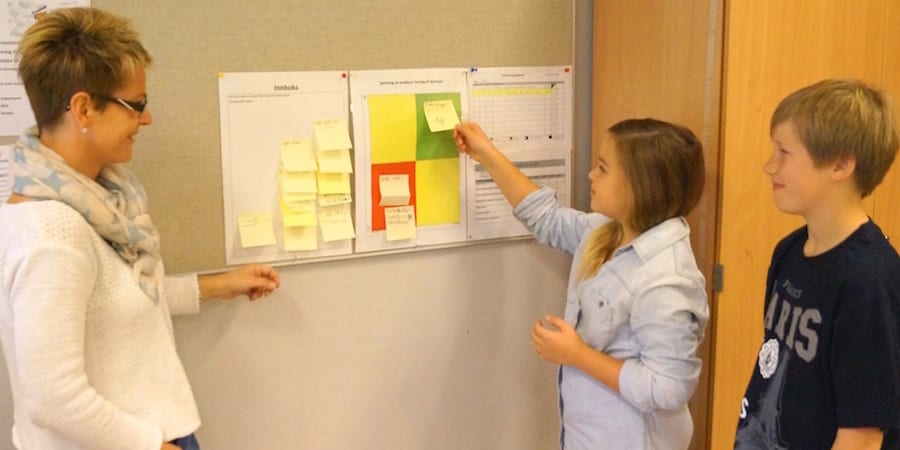
An interview with Ian Hurst and Keith Edwards, Toyota
INTERVIEW – At the recent UK Lean Summit, Ian Hurst and Keith Edwards of the Toyota Lean Management Centre ran an insightful workshop on standard work. We sat down with them to discuss standardization, respect for people and waste elimination.
Interviewees: Ian Hurst, Principle Engineer, Toyota Lean Management Centre and Keith Edwards, Section Manager, Toyota Motor Manufacturing
Interviewer: Roberto Priolo, Editor, Planet Lean
Photo credit: JuliusKielaitis / Shutterstock.com
Roberto Priolo: What do you find to be the thing that organizations struggle with the most as they try to introduce standard work?
Ian Hurst: Too often organizations try to standardize an unstable process, which is of course very difficult to do. Without stability your standardization efforts will fail, there is no question about that.
The foundation must be problem solving, which is what Toyota has essentially spent 80 years doing. Problem solving gives us the level of stability that we need to introduce standardized work cycles and improve. Just-in-time and jidoka help us to expose the next level of problems, or “create a crisis” if you will.
RP: How often are standards reviewed at Toyota? What’s the process like?
IH: One of our Executive Vice Presidents at Toyota in Japan, Nimi-san, said that “it is up to production management to set the standard and up to the shop floor to break it.” People will find a better way. The key to that is then re-standardizing, re-training everybody and making sure the standard is being followed consistently, until we find the next improvement. It is not an explicit activity, and the company’s expectation is that we do this every day, that we improve all our processes every day. That’s what continuous improvement means.
Keith Edwards: The standard is very much the beginning of the journey. If you try something new and it doesn’t work, the worst thing that can happen is that you go back to the original standard. This limits the risk, because all you are doing is improving an already-existing standard.
RP: People who are not used to applying lean often fear that standards will stifle creativity in their organizations. What do you normally respond to those who raise such concerns?
KE: Let’s take a doctor in a hospital as an example. We would see him or her as an expert, who doesn’t have to spend time on mundane tasks. If we can remove and standardize a portion of his/her activity, he or she can use his/her real expertise to look at the higher end.
IH: Standardized work is not a straitjacket, but a framework. Within it, there is always room to move, to find that better way I mentioned above. Before you can do that, however, you need to build a certain level of trust on the shop floor. Our people know that if their job is improved and time is freed up, we will always find more value-creating activities for them to do.
RP: In your mind, what does respect for people look like?
KE: People give us 8 to 10 hours of their day, and respecting them means to use that time correctly. We don’t want to have them running around like headless chickens. Instead, we want to ensure their time is used for value-added activities, so that when they go home they know they have contributed to what Toyota is trying to achieve.
That’s why we look at how we can enhance their daily work. We give them control of the process, and the tools that help them to improve it (it’s both physical tools and the ability to problem solve). We give people basic skills so that they can do the improvement and solve problems themselves.
IH: With every pair of hands comes a free brain. If, as a manager, you decide not to engage that, it’s your failure. Don’t just engage the hands (have people do the production work) but also the brain (have them come up with better ways of doing things). A brain left at the gates has no value to us. We strongly believe that all our people have something to contribute to the improvement of our process.
RP: If in the eyes of Toyota overproduction is the mother of all wastes, because it generates all other forms of waste, what would the mother of all principles/countermeasures be?
IH: Takt-time manufacturing. Fundamentally, that’s what it is all about: making products at the rate the customer wants us to make them. That means we can minimize our inventories and that we don’t need systems to manage that inventory. It means that we don’t incur the additional risk of building more parts, which might end up being defective and reaching the customer (at that point, finding the root cause would be extremely difficult).
KE: Takt also challenges you to have a stable, reliable and repeatable process. You need to make things in the hours you have, and that limits the stock you can build up. It also helps you to respond quickly and flexibly to fluctuations in demand.
IH: TPS describes a perfect system. We have Toyota’s current production system and we have TPS, and there is a gap between the two. We strive to build that ideal system that allows us to appropriately respond to real customer demand every day (which means we should always be able to product to takt). That’s exceptionally difficult to manage, but it’s where we want to get. Will we ever get there? We’ve been at it for 80 years and we are still a long way away. But that doesn’t mean we will stop trying.
RP: What has Toyota learned from the mistakes it made over the years?
IH: We expanded too quickly, and we experienced recalls and other problems as a consequence. There is no doubt some of it came from our loss of focus on the customer. We were talking about expanding our capacity, but the customers don’t care about that – they care about quality. Our focus had really drifted. Top management is now focusing again on meeting customer needs, and that was a great learning for us. We have done reflection on it, and that’s going to make the difference for Toyota.
RP: Do you think the same mistakes won’t be made again because there is a system for learning in place?
KE: Yes. When it comes to PDCA, the C and A phases are the ones people tend to struggle with the most. Toyota, however, is great at reflecting on what goes wrong. The importance of continuous reflection cannot be overstated.
RP: At TLMC, what is your approach to documenting the learning that you gain from working and helping so many organizations?
KE: It’s that same system of reflection. After every job, we do hansei using an A3. We try to understand what made us successful (or unsuccessful) so that the next time we can support other organizations better.
RP: Why does Toyota help others?
IH: Built in our fundamental principles is the idea of being a good corporate citizen and helping the world develop. A lot of the ideas that were in place in 1934 when the company was founded are still our core beliefs. That’s why we are not for profit at TLMC: we don’t think we should profit from sharing what we learn. This creates healthy competition and it encourages us to always do better.
Planet Lean has featured two organizations that have benefited from Toyota's help to kick-start their lean transformations, this time in the United States.
Toyota Production System Support Center has helped The Food Bank for New York City deliver more food to more people in need in the Big Apple, and the St. Bernard Project to rebuild more houses in post-Katrina New Orleans than even before.
Come back to Planet Lean next month for an example from the United Kingdom
Read more


FEATURE – Resilience and the ability to self-organize have been part of Ukrainian culture for centuries. Today, as the war continues, the country’s companies and resistance are tapping into those values.


CASE STUDY - A pioneering school in Rogaland, Norway, is proving that some elements of lean thinking can successfully be adapted to the education system to create better conditions for both teaching and learning.


FEATURE – If we see lean thinking as a paradigm, which we do, then we should be able to define a set of values this paradigm is built on. So, are there lean ethics? Michael Ballé identifies 10 undisputed lean values, plus one.


INTERVIEW – At the recent European Lean Healthcare Transformation Summit, we sat down with Helen Zak for a few minutes to discuss the state of change in the healthcare sector.

